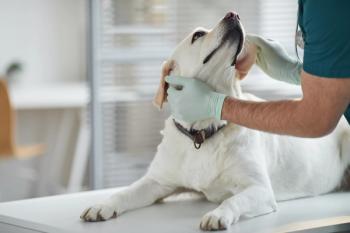
Canine Cushing's Case Files: The ins and outs of detection and treatment-Case file: Your veterinary team's role in treating and monitoring dogs with hyperadrenocorticism (Sponsored by Dechra Veterinary Products)
Well-trained technicians and other team members can help reinforce veterinarians' messages to clients about signs of illness in pets, the advantages of early disease recognition and treatment, and the importance of follow-up care.
Veterinary team members are instrumental in communicating with your clients — during visits, on the phone, and through email and social media. Well-trained technicians and other team members can help reinforce veterinarians' messages to clients about signs of illness in pets, the advantages of early disease recognition and treatment, and the importance of follow-up care. Team members should understand hyperadrenocorticism, a common endocrine disease in middle-aged to older dogs, so they are comfortable communicating with clients who have pets that are affected.
The previous Canine Cushing's Case Files article reviewed what team members should know about canine hyperadrenocorticism (HAC, also known as Cushing's syndrome) to help veterinarians identify potential Cushing's patients. It also reviewed the diagnostic procedures that are needed to reach a diagnosis of HAC and the team's role in helping to explain the tests to clients. This article focuses on what team members should know about HAC to help veterinarians successfully treat and monitor dogs with this disease.
Your team supports treatment
Once canine HAC has been diagnosed, team members can reinforce the veterinarian's messages to clients about the importance of treatment. If left untreated, the clinical signs will progress, and HAC increases a dog's risk of developing serious problems such as chronic infections of the urinary tract, skin, and ears; diabetes; thromboembolic events; proteinuria; and hypertension. The treatment goal is to maintain a good quality of life by alleviating clinical signs and secondary medical conditions.
Teach your team about treatment options for canine HAC. VETORYL® CAPSULES (trilostane) are the only FDA-approved treatment for both pituitary-dependent hyperadrenocorticism (PDH) and adrenal-dependent hyperadrenocorticism (ADH) in dogs. The active ingredient in VETORYL Capsules — trilostane — blocks an enzyme in the cortisol production pathway, which decreases cortisol in the body and reduces clinical signs. VETORYL Capsules are clinically effective in treating dogs with PDH and ADH; the drug does not, however, affect tumor growth.
Your team members can also share success stories with clients about other patients with HAC that have been treated at your practice. Clients like to know what to expect from treatment and appreciate hearing about other pets that are being successfully managed.
Your team supports monitoring
If patient management is to be successful, your team should reinforce your instructions to clients about VETORYL Capsules administration and the follow-up visits needed to assess their dogs' responses. Team members can reinforce the veterinarian's message that HAC is a disease that is managed rather than cured, and that dogs with HAC are treated for life and need to be monitored regularly.
Team members should also reiterate that occasionally a dog's dose of VETORYL Capsules might need to be increased, decreased, or temporarily discontinued to ensure effective treatment without side effects of hypocortisolemia. The need for such dose adjustments can only be determined through regular rechecks that include a physical examination and blood tests. Pet owners must understand these points to achieve successful treatment outcomes.
Before treatment begins, team members can suggest that either the pet owner or the clinic obtain pretreatment photos. Because a treated dog's physical improvements may take a few weeks to months to see, photos can help document response to treatment. And with an owner's consent, the photos may be used to show other clients when the team is sharing successful treatment stories.
Day 1 of treatment
Team members should reiterate the veterinarian's instructions to clients about how to give VETORYL Capsules. The drug is given once a day in the morning, and it should always be given with food to enhance drug absorption. The team should also be sure the client understands what changes to watch for in the pet at home.
Because VETORYL Capsules act by decreasing cortisol in the body, a patient may exhibit signs of hypocortisolemia, or too little cortisol, so team members must also reinforce the veterinarian's instructions to clients about what to watch for at home. Signs of hypocortisolemia include vomiting, diarrhea, lethargy/collapse, and loss of appetite.
Before the client leaves the clinic, a team member should schedule a recheck examination for 10 to 14 days after beginning VETORYL Capsules treatment. Team members can reinforce the veterinarian's instructions that each recheck visit will include a history, a physical examination, electrolyte concentration measurements, and an adrenocorticotropic hormone (ACTH) stimulation test.
Day 2 or 3
Two or three days after starting treatment, a team member should call the client to follow up and ask specific questions. Good questions to ask include:
- "Do you have any difficulty giving the medication?"
- "Are you giving the drug with food?"
- "Has the dog vomited or had any diarrhea?"
- "Have you noticed any changes in your dog's appetite?"
- "Have there been any changes in the dog's activity level?"
- "Do you have any questions for me or for the doctor?"
Team members should immediately report any improvement or worsening in clinical signs to the veterinarian and document the discussion in the dog's medical record.
Day 9 to 13
The day before the first recheck appointment, a team member should call the client with a reminder that VETORYL Capsules should always be given with food, even on the day of testing. Furthermore, the client should be told that timing of the ACTH stimulation test is important; the test needs to be done four to six hours after the dog is given VETORYL Capsules in the morning because maximum cortisol suppression occurs during that time. Thus, the team member should stress that the pet needs to be in the hospital and ready for blood testing at the appropriate time.
Day 10 to 14
The 10- to 14-day recheck visit includes a history, physical examination, reevaluation of the dog's electrolyte concentrations, and an ACTH stimulation test. Before each ACTH stimulation test is performed, team members should confirm that the owner gave the VETORYL Capsules to the dog that morning, with food. If the owner did not do this, the recheck should be rescheduled. Team members can ask clients to complete a "VETORYL Capsules Monitoring Form" (see boxed text "Readymade Tools for Training Your Team and Educating Clients") when clients present or drop off their dogs at the clinic for rechecks.
Readymade Tools for Training Your Team and Educating Clients
Each recheck visit allows team members and the veterinarian to talk with owners about how the pet is doing at home. Within two to four weeks of the start of treatment, the owners should begin seeing improvements in their dogs' clinical signs — increased energy levels, more normal water and food intake, and fewer accidents in the house or less frequent requests to go outside. Improvements in a dog's coat and skin will take three to nine months.
Team members can again help reinforce the veterinarian's message that a dog with HAC requires long-term treatment and routine monitoring. A need for a dosage change can only be determined by the veterinarian performing regularly scheduled physical examinations and diagnostic tests, along with a clear understanding of the clinical picture of how the dog is doing at home. Therefore, your team will be important partners with clients to ensure the dog is monitored carefully.
Before the client leaves, a team member should again schedule a recheck examination for the appropriate time — either 10 to 14 days after any VETORYL Capsules dosage change, or if the VETORYL Capsules dose is not changed, the recheck is scheduled for 30 days after beginning VETORYL Capsules.
Your veterinary team can help remind owners of the required follow-up visits by creating a recheck calendar. They can also schedule periodic phone calls to the client to see how the dog is doing at home. Furthermore, everyone on your team needs to emphasize that the pet should return immediately to the practice any time the dog becomes ill or if signs of HAC recur.
Four weeks and beyond
Once an optimum dose of VETORYL Capsules has been reached, dogs need to be reevaluated at regularly scheduled recheck visits at 30 days, 90 days, and every three months thereafter, or 10 to 14 days after any change in the dose of VETORYL Capsules.
The day before each recheck appointment, team members should call clients to remind them that VETORYL Capsules should always be given with food, even on the day of testing, and that the ACTH stimulation test needs to be done four to six hours after the dog is given VETORYL Capsules.
Listening to clients is a key component of successful VETORYL Capsules treatment. Technicians and receptionists have prime opportunities to help veterinarians assess the health of pets receiving VETORYL Capsules. Team members are the veterinarian's frontline eyes and ears, and at each recheck visit, a team member should specifically ask clients
- "Do you feel like your dog's previous clinical signs are well-controlled?"
- "Has your dog exhibited any new signs or conditions that concern you?"
Team members should report the answers to the veterinarian and should know that any signs such as vomiting, diarrhea, lethargy, or anorexia must be investigated.
Educate, empower, and motivate clients
Keeping owners educated, empowered, and motivated will help make treatment and monitoring of dogs with HAC more rewarding and support long-term success. Hyperadrenocorticism is a complex disease process, but successful management is possible with the help of a dedicated veterinary team.
Learn more with these online resources
Go to the Dechra Veterinary Products CE Learning Center at
• Diagnosing and treating canine hyperadrenocorticism
Presented by Audrey K. Cook, BVM&S, MRCVS, DACVIM, DECVIM, and David s. Bruyette, DVM, DACVIM
• Cushing's disease: Inside and out
Rhonda Schulman DVM, DACVIM, and John Angus, DVM, DACVD
• Diagnosing and treating feline hyperthyroidism
Presented by Andrew J. Rosenfeld, DVM, DABVP
Then get your whole team on the same page, by visiting the Team Meeting in A Box section at
• Stop getting burned by ear infections
How you handle otitis externa and ear infections can make or break client bonds—and dogs' well-being. Use this Team meeting in a Box to create a team approach to help pet owners and heal patients.
• Coping with Cushing's syndrome
Pets with Cushing's syndrome suffer from a chronic illness that will be managed throughout the pet's life, not cured. This Team Meeting in A Box will help you deliver a successful team-wide approach.
Visit
Newsletter
From exam room tips to practice management insights, get trusted veterinary news delivered straight to your inbox—subscribe to dvm360.






